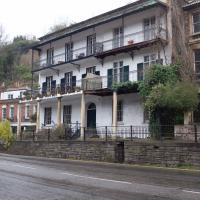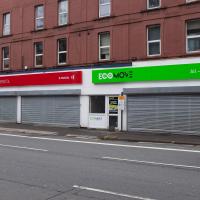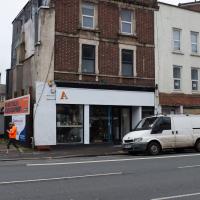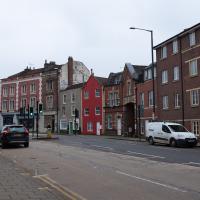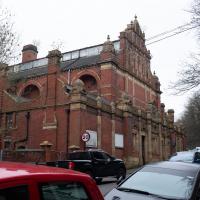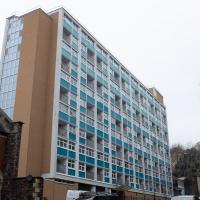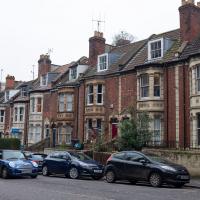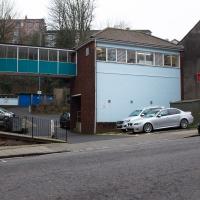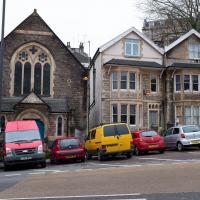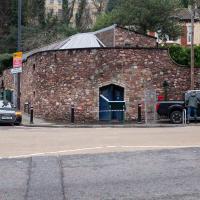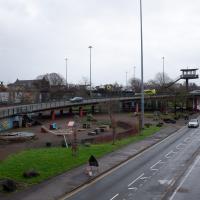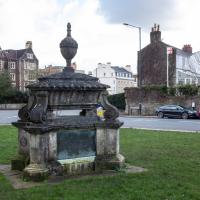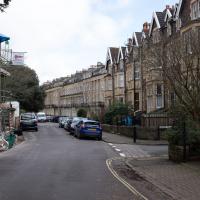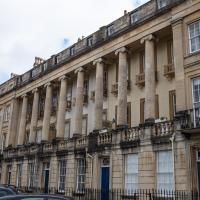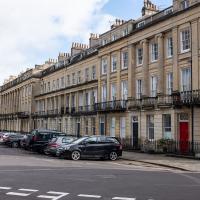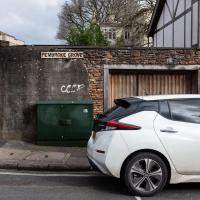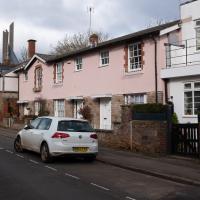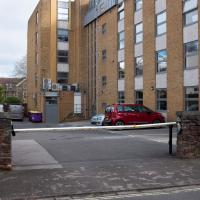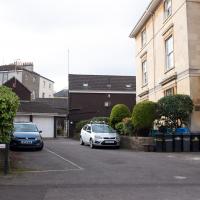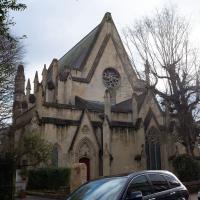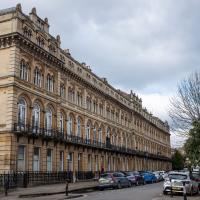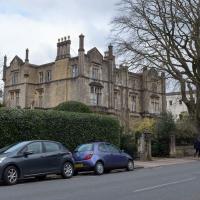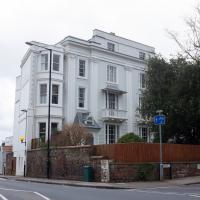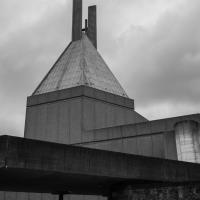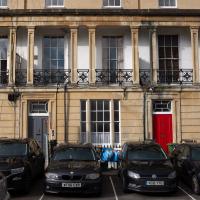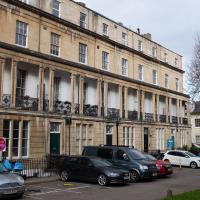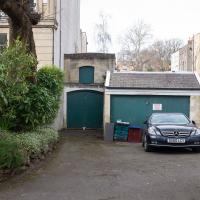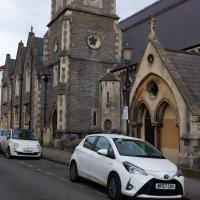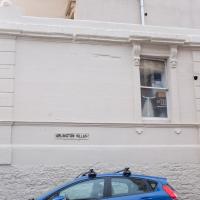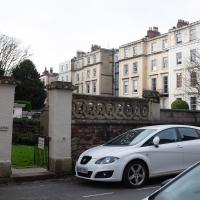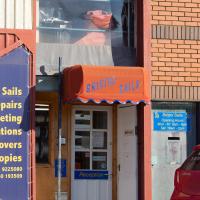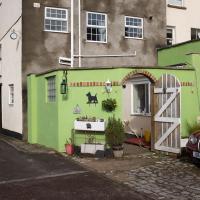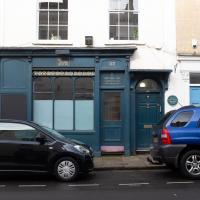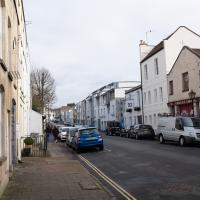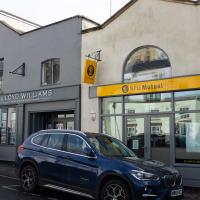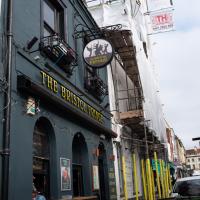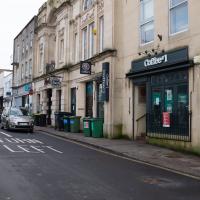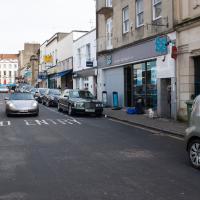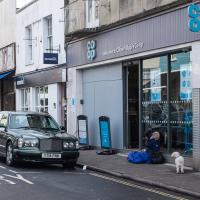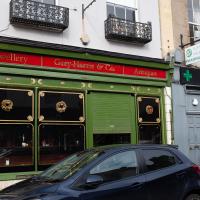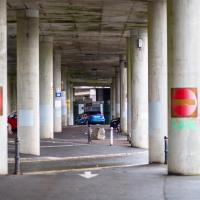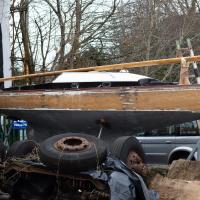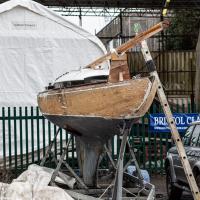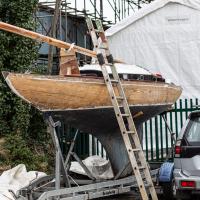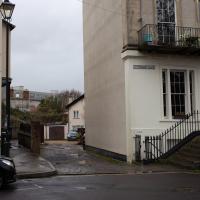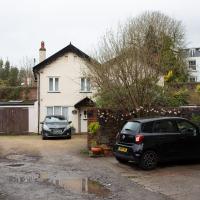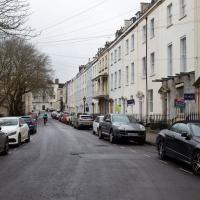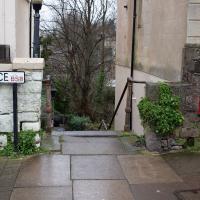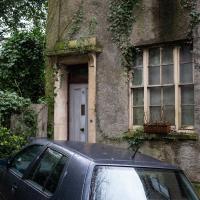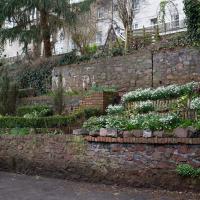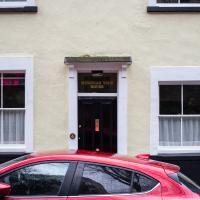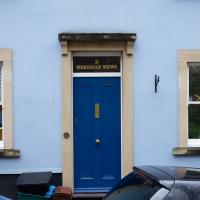Tagged: car
Unexpected Snow
31 Jan 2021
I just nipped out to post a blood test (not Covid-related) and check that my car was okay, because I've not driven it for weeks. I was just going to walk up to Clifton Village, but I spotted the opportunity to re-park the car on my street rather than up the hill around the corner where it was, so instead I got in, intending just to move a hundred metres, but it turned over slowly before it started, and then warned me that the battery was very low and I should go for a long drive to recharge it.
So, I did my best, zipping up the A4018 to the motorway junction and back again, dropping off my blood at a postbox along the way, and while I did that, it started snowing. I noticed it was low tide, too, so when I got back home I headed back out again, this time on foot and with a camera so I could see if I could find any evidence of the Hot Well steaming.
I saw not a single sign of the Hot Well steaming, but it was quite a nice quick outing and I enjoyed my brief walk in the snow. Iike Hinton Lane, too, and while it's all old ground I was re-treading, I did at least get a picture or two with a bit of snow and some of the cold winter atmosphere of the trip, I think.
Jacob's Well Wander
01 Feb 2021
I just wanted to get some exercise, really, so I set out to knock off the lower bit of Jacobs Wells Road that I'd not managed to walk up yet. I set the new signboard that the community association had had erected as my destination, after reading about it on their blog.
As it turned out, I couldn't even read it, as the building that houses the actual Jacob's Well had water flooding out onto the pavement. I wonder if it was actual Jacob's Well water? Have the soles of my walking shoes been mystically blessed now?
You can't see much of the flood in the photos I snapped, but I did shoot a little video, too. Ed on Twitter said:
I spoke to the seller at the time with a view to buying it - I mentioned an old friend who grew up nearby remembers it flooding regularly. He swore blind my friend was wrong.
The first local electric bike shop was at the bottom of Jacobs Wells Road; it seems to have attracted some larger competition. I think this place was a sporting goods shop before, specialising in cricket equipment, if my memory isn't deceiving me. When the shutters are up, they've got a large range of electric bikes and scooters on display.
It's a bit higgledy-piggledy, this little stretch that leads to the car park by the Grain Barge mooring. The Thai restaurant at the end was a fusion restaurant called Michael's with an excellent reputation when I first moved to Hotwells. The Thai is great, from what I remember, but I don't eat out very often, not even locally.
Laundry room? I took a guess at that and googled it and apparently there is "a useful communal laundry room", so it seems likely.
Sandwiched between residences, the Brandon Free Methodist Church is now also, of course, residential. In its time it's been "a Buddhist Centre, a martial arts school, and Bristol Society of Magic."
This is what I actually came to see -- the signboard in front of the old Jacob's Well building. Recently refurbished for residential use and sold with a commercial licence for bottling the water. However, the signboard was behind the cordoning-off, because there was water flooding out of the building! Ooops...
Greville Smyth Path Completionism
02 Feb 2021
I needed to get away from my desk at lunchtime, and I saw a little segment of path in Greville Smyth Park that needed knocking off my "to walk down" list, so that gave me a target. Sadly Hopper Coffee's little Piaggio Ape wasn't there to sell me a coffee. I hope Rich is all right, not seen him so far this year.
Anyway, a fairly uneventful walk. They're putting new boundary fencing up around Hotwell Primary School (I wandered down Albermarle Row to see what the pneumatic drilling was about), the house on Granby Hill that's been covered in scaffolding and swaddled in protective sheeting has finally been revealed in its cleaned and refurbished form, and they were doing something to the flyover that leads up from the end of the Portway/Hotwell Road to the Plimsoll Bridge. Nothing much else to report.
Lots of work going on at the top of the ramp. Wonder if yet another truck ran into it, or if it's just routine work.
You can't see what's going on at the top of the flyover, but you can certainly tell that there's a lot of work vehicles up there.
Easy to miss in the previous photo. I didn't have a camera with a zoom lens today. The Fujifilm X100T is a fantastic camera for many purposes, but zooming in on distant details is not one of them.
A wander to knock off a couple of bits around Clifton Park that I'd missed out on previous excursions. This one took in the drinking fountain near Sion Hill and explained a little of how the Seven Years War, which ended in 1763, still has some history on display near Manilla Road.
This sarcophagus surmounted by an urn is a 1767 memorial to the dead of the Seven Years War.
Leading off the far side of the roundabout in the background is Manilla Road, former site of Manilla Hall, built by General Sir William Draper, whose victories include capture of Manilla City in 1762. This cenotaph and the adjoining obelisk to Pitt used to stand in the grounds there.
...looking toward Vyvyan Terrace. On the left, a man was doing what looked like some re-pointing work.
I'm starting to get the hang of which is which. These are Ionic. You can tell by the volutes.
From the Clifton and Hotwells Character Appraisal:
Vyvyan Terrace (1832 -1846) by Richard Shackleton Pope, was named after the Tory MP Sir Richard Vyvyan, who won the 1832 parliamentary election by defying the Reform Bill & bribing 1200 voters.
Nos. 14-17 were the first to be built and stood alone for many years before the rest of the terrace was completed. The group sits on a privately owned raised pavement and railings were replaced as a community project in the late 1970s.
It seems unlikely the CCCP will have much of a hold over Clifton, graffiti notwithstanding.
I think I've snapped this before, but I do rather like the pink and cute little Pembroke Mews.
(Photographic Lack of) Worcester Terrace
09 Feb 2021
A nice walk, but something of a failure, photographically. I went to knock Worcester Terrace off my list, a not dissimilar terrace to Vyvyan Terrace, but one street further away from me. Like yesterday, it was very chilly but this time I went prepared with an extra layer and a winter coat. I think this may have been my downfall, as it may have been the X100T's control wheel brushing against the coat that put it in aperture priority mode at f/16, which I didn't notice at the time, and made most of my photos a little too blurry to use. Apparently in this mode, the X100 doesn't bump up the ISO if it can tell things might be a little too wobbly. Ah well.
So, a nice enough walk, and technically I did Worcester Terrace, but if you didn't take a photograph, were you really there? I'll have to go back...
From the listing:
Pair of attached houses. 1846. Limestone ashlar with external and party wall stacks, roof not visible. Double-depth plan. Tudor Gothic Revival style. Each of 2 storeys, basement and attic; 2-window range. A detailed, symmetrical front has projecting wings with small gables and octagonal, panelled buttress-turrets with octagonal finials; weathered sill bands, a moulded parapet, paired buttresses to the party wall linked by a raised parapet, and side entrances.
I don't know much about architecture, but I understand that if your porch has a dormer, you're probably quite well-off.
Arlington Villas and WH Smith Destruction
10 Feb 2021
I actually dashed up to Clifton to take a look at Arlington Villas, just around the back of St Paul's Road, one of those slightly odd little enclaves of overlooked housing that you know is there, but you never have a reason to visit or travel down. As it turned out, interesting though the (public) garden is, I actually took far more pictures of the now-completely-demolished site bounded by King's Road, Boyce's Avenue and Clifton Down Road where WH Smith and other places used to stand.
It's interesting to imagine how nice this little area would be if turned into a permanent public square, but of course the developers already have their planning permission to build it right back up again.
Are these balconies? Or is it technically a loggia? Oh, according to the listing, it's:
Recessed first-floors behind a stone colonnade with paired, panelled columns to an entablature.
I'll never get the hang of what's what in architecture.
Another day, another coffee. I think I may have knocked a tiny footpath in Baltic Wharf from my list of leftover paths in the area, but mostly this walk was about getting out into the crisp February cold and enjoying the walk. On the way I posted a letter at 13 Dowry Parade (home of a surgeon called Willam Falls back 1830, according to Pigot's Directory of Gloucestershire...) and pondered the strange duality of Dowry Parade and Hotwell Road, then wandered through the Dowry Parade end of Cumberland Piazza, enjoying the clean lines of the glyph graff, before taking the causeway route past a Cumberland Basin empty of water but full of seagulls, to make my way south of the harbour.
Clifton Village, including Oxford Place
15 Feb 2021
I've noticed Oxford Place as a tiny little side/back road I've overlooked on my wanders a few times. Today I decided to pop down and have a look, as well as taking a few general snaps of Princess Victoria Street, which I thought deserved more pictures, as it's basically my closest decent shops, and in the Beforetimes I'd visit the Co-Op up there all the time, as well as the cafes (you'll be missed, Clifton Village branch of Boston Tea Party, recently closed in favour of Eat a Pitta.)
I'm definitely becoming more familiar with the area through the One Mile Matt jaunts and associated reading. Today I didn't just think, "oh, I'll head home down that weird alleyway with the electrical substation in it"—no, I thought, "I'll head home down Hanover Lane", because I actually knew its name. And on the way back from there I nodded sagely to myself as I passed St Vincent's Road, knowing now which St Vincent it's likely to be (St Vincent of Saragossa) and also eyed up the modern flats on Clifton Vale and wondered if they might have been built on the site of the former Vauxhall Pleasure Gardens... I don't know all the answers, but at least I have some idea of the historical questions I'm interested in.
There was a sign at the end basically advising you to naff off if you weren't a resident, or invited by one, so I didn't hang around.
Never been in in its current incarnation. Can't remember what it was called before, but it's the only place I've eaten posh enough that I had to pick a bit of shot out of the partridge. As Wallfish it's had a lot of good press, including from Jay Rayner ("a kitchen skilled in all the right departments".)
Edit: having checked, it seems it's just shut, and will be consolidating with a restaurant called Wellbourne on the Mall, around the corner. Ah well. I probably won't eat there, either.
Last time I was in I saw a jazz gig in the back room. It wasn't entirely my cup of tea, but hey, it was better than being cooped up at home for a year, so Yay! for the Beforetimes.
Their coffee is pretty reliable, but the last few times I've been in one member of staff or another has had ther nose poking out over their face mask, and it's not exactly well-ventilated in there. I think I'll steer clear until the pandemic's over. Spicer+Cole, Foliage and Twelve are all better bets at the moment, for excellent coffee and for not dying of an infectious disease.
The 2001 Bentley Arnage Red Label with its 6750cc engine would have retailed for around £140,000. Probably not enough to buy the cold bloke in front of the Co-Op a place in Clifton Village—I just checked, and the nearest available one-bedroom flat is £275,000—but he could probably rent one for a good long time.
Little Victories
16 Feb 2021
There's a dearth of my favourite coffee places on a Monday and Tuesday at the moment. Both Twelve and Imagine That are closed on Monday and Tuesday, and Rich from Hopper Coffee doesn't seem to have come back from Christmas break. Today I pushed on a bit further than normal around the harbour and got to Little Victories, the always-reliable sister cafe to Small Street Espresso, based at Wapping Wharf. Along the way I saw graffiti, my second reference to one of Bristol's twin cities in two days, and a rather sleek little boat outside Rolt's Boat Yard.
Meridian
17 Feb 2021
The long road between Clifton Road and Park Place—the little triangle of grass in front of the Pro-Cathedral, which also houses Quinton House pub, the Park Launderette and Mr Swantons Barbers—is one I've travelled a lot, as it's a nice route between my place and the top of Park Street, especially Ocado. It has many names along the way, even though it feels like just one continuous road. It's York Place, Tottenham Place, Meridian Place and Bruton Place before it finally spits you out onto Park Place.
It was Meridian Place I was interested in today, as I wanted to explore the set of steps that lead down from it in the direction of Jacobs Wells Road. Turns out they lead to Meridian Vale and Meridian Mews, and come out between the Strangers Burial Ground and the Eldon House, opposite the entrance to Bellevue Terrace. I liked the little terrace on Meridian Vale, though they probably don't get a lot of light in the front windows, what with Meridian Place and Tottenham Place towering above them.
On the way back home I popped into the little lane behind Regent Street that houses the Chesterfield Hospital, as I realised I'd neglected that up until now. It was... unexciting.
There's usually one rather sadder looking house in any given Clifton terrace.
I think the way it works is that the first two houses from this end are 1 and 2 Meridian Mews, followed by Meridian House, followed by 1-8 Meridian Vale. Not confusing at all.
